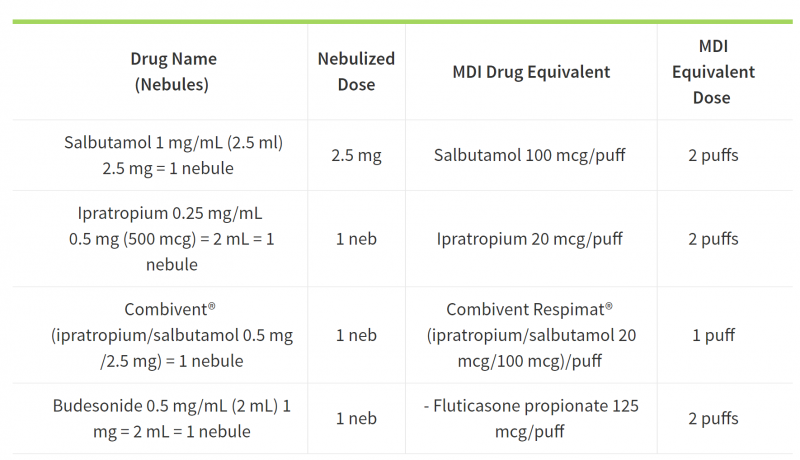Recommendations for Use of Meter-Dose-Inhalers (MDIs) during Respiratory Outbreaks and Influenza-Like Illness (ILI) in Long Term Care Homes
This memo was sent from Patrick Robertson, Executive Director – Pharmacy Services on March 21, 2020
The following are SHA Pharmacy Services suggested strategies for inhaled bronchodilators and steroids in LTC homes during respiratory outbreaks and for managing ILI.
When patients require treatment with ILI symptoms or a respiratory outbreak is declared in a LTC home, it is advisable to avoid the use of nebulized medications to help reduce the risk of transmission of infection.
Suggested alternatives to wet nebulization include:
- Salbutamol metered dose inhalers (MDI), Ipratropium MDI, Combivent Respimat® (ipratropium/salbutamol) MDI and Fluticasone MDI.
- Dose conversions are included in the table below
Metered dose inhalers are for individual patients and must never be shared.
Other medications and normal saline administered by nebulizer require case-by-case evaluation.
For those patients unable to derive benefit from MDIs, continuing nebulized therapy for symptom relief maybe necessary and may require patient isolation and appropriate PPE for healthcare workers (please refer to PPE guidelines). Dilution of nebulized products should be eliminated to minimize nebulizing time. Positive and suspected COVID-19 patients requiring nebulization should be on droplet and airborne precautions.
Regarding spacer devices (e.g. Aerochambers):
- MDIs can be used alone or with a spacer device.
- Use space devices when patients have difficulty coordinating breathing in and activating an MDI.
- Consider using space devices with MDIs that deliver inhaled corticosteroids
- Only use spacer devises with a pressurized inhaler, not with a dry-powder inhaler
Medication changes in Long Term Care Homes should be coordinated with contracted pharmacies.
Resources
S.A. Alhaider, H.A. Alshehri, K. Al-Eid. Replacing nebulizers by MDI-spacers for bronchodilator and inhaled corticosteroid administration: Impact on the utilization of hospital resources. International Journal of Pediatrics and Adolescent Medicine,Volume 1, Issue 1, 2014,Pages 26-30


